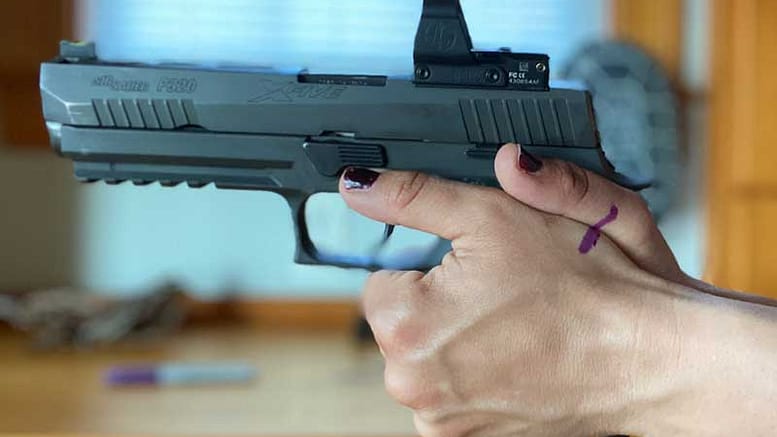We’re headed back to the dry fire practice ring to bring you another fun activity to beat the boredom and improve those shooting skills. Today, let’s work on drawing from the holster. A good, clean draw can make all the difference in a high-stress, self-defense scenario and it can shave up to a minute off your time in competition.
What you will need
*Before running any dry fire drills, visually and physically inspect your gun is clear, then clear the area of all live ammunition. *
Drill 1: Grip consistency

The line helps get a consistent grip. (Photo: Taylor Thorne/Guns.com)
Draw your firearm. Using a marker, draw a line over both hands where they meet thumb-side. This allows you to see if your hands are consistently meeting in the same place.
Drill 2: Draw height consistency
Draw and present the firearm approximately 2-inches from a wall or target. Use a piece of tape to note where the gun was pointed after the draw. The tape will act as a visual indicator to ensure you are raising the gun to the same spot each time, ultimately building muscle memory. Make sure when drawing, you bring the sights to your eyes.
Drill 3: 50% speed draw
With a weighted magazine inserted into the handgun, holster the gun and draw at 50% speed towards a target or aim point. Focus on establishing a proper grip and looking down the sights as you push the pistol towards the target.
Drill 4: 75% speed draw
With a weighted magazine inserted into the handgun, holster the gun and draw at 75% speed towards a target or aim point. Focus on maintaining proper technique.
Drill 5: Draw from surrender
With the handgun holstered and weighted magazine inserted, draw from the surrender position. The surrender position is defined as wrists above shoulders. For best results, develop a touchpoint, or location your fingers touch every time. Ear pro or the bill of a hat works well as a touchpoint to ensure a consistent draw each time.
Drill 6: Turn and draw
With the handgun holstered and weighted magazine inserted, start with your back facing the target in either the surrender position or with relaxed hands at the side. At the start signal, turn to face the target and draw. Do not break the 180-degree plane as your turn to draw. Also, reholster before turning around and restarting the drill. Always practice basic safety as if you are on the range even when you are not.
Tip: If you turn to the side with your gun, a draw can be completed quicker. Use the momentum of your turning body to help guide the firearm out of the holster. Also, consider foot movement. On a smooth surface, you can pivot, but on a rocky surface, a two-step turn is needed.
Final Thoughts
Get to dry firing and track your progress. Remember consistency is key! If you can perfect your draw while off the range, it will only improve your performance on the range.
The post Dry Fire Basics – Practice the Draw to Save Time appeared first on Guns.com.
Powered by WPeMatico

